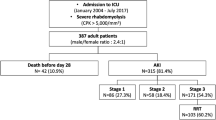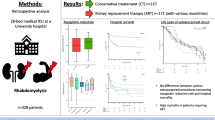Abstract
Background
Mortality with rhabdomyolysis-associated acute kidney injury can be as high as 80%. Experimental data from mouse models of rhabdomyolysis showed that paracetamol reduces the expected increase in serum creatinine level. We aimed to assess the association between paracetamol use and the need for starting renal replacement therapy (RRT).
Methods
We conducted a propensity score-matched cohort study in Orléans Hospital, France (a 1136-bed, public, university-affiliated and teaching hospital). All patients with serum creatine phosphokinase (CK) level > 5000 IU/L between January 1st, 2008 and December 31st, 2017 were included. A propensity score was calculated for each included patient by using multivariable logistic regression and all available baseline characteristics. The main outcome was the incidence of RRT initiation from day 1 to day 28 in the propensity score-matched cohort between patients exposed and unexposed to paracetamol.
Results
Over the study period, 1065 patients with at least one CK level measurement > 5000 IU/L were included; 40 (3.8%) had at least one RRT session. Among the 343 matched pairs, 10 (2.9%) exposed and 24 (7.0%) unexposed patients underwent RRT before day 28 (P = 0.021). Primary time-to-event analysis showed that exposure to paracetamol was significantly associated with reduced absolute risk of RRT: absolute risk difference = − 3.18% (95% CI − 5.23 to − 1.20, P = 0.001). All secondary analyses showed a significantly reduced absolute risk of RRT in patients exposed to paracetamol.
Conclusion
Our study showed a significant association between paracetamol exposure and reduced incidence of RRT among patients with rhabdomyolysis.
Graphic abstract



Similar content being viewed by others
Data availability
The datasets generated and/or analysed during the current study are available from the corresponding author on reasonable request.
Code availability
not applicable.
References
Huerta-Alardín AL, Varon J, Marik PE (2004) Bench-to-bedside review: Rhabdomyolysis–an overview for clinicians. Crit Care 9:158–169. https://doi.org/10.1186/cc2978
Zutt R, van der Kooi AJ, Linthorst GE et al (2014) Rhabdomyolysis: review of the literature. Neuromuscul Disord 24:651–659. https://doi.org/10.1016/j.nmd.2014.05.005
Brown CVR, Rhee P, Chan L et al (2004) Preventing renal failure in patients with rhabdomyolysis: do bicarbonate and mannitol make a difference? J Trauma 56:1191–1196. https://doi.org/10.1097/01.TA.0000130761.78627.10
El-Abdellati E, Eyselbergs M, Sirimsi H et al (2013) An observational study on rhabdomyolysis in the intensive care unit. Exploring its risk factors and main complication: acute kidney injury. Ann Intensive Care 3:8. https://doi.org/10.1186/2110-5820-3-8
Safari S, Yousefifard M, Hashemi B et al (2016) The value of serum creatine kinase in predicting the risk of rhabdomyolysis-induced acute kidney injury: a systematic review and meta-analysis. Clin Exp Nephrol 20:153–161. https://doi.org/10.1007/s10157-015-1204-1
McMahon GM, Zeng X, Waikar SS (2013) A risk prediction score for kidney failure or mortality in rhabdomyolysis. JAMA Intern Med 173:1821. https://doi.org/10.1001/jamainternmed.2013.9774
Bagley WH, Yang H, Shah KH (2007) Rhabdomyolysis. Intern Emerg Med 2:210–218. https://doi.org/10.1007/s11739-007-0060-8
Bosch X, Poch E, Grau JM (2009) Rhabdomyolysis and acute kidney injury. N Engl J Med 361:62–72. https://doi.org/10.1056/NEJMra0801327
Boutaud O, Moore KP, Reeder BJ et al (2010) Acetaminophen inhibits hemoprotein-catalyzed lipid peroxidation and attenuates rhabdomyolysis-induced renal failure. Proc Natl Acad Sci 107:2699–2704. https://doi.org/10.1073/pnas.0910174107
Billings FT IV, Petracek MR, Roberts LJ II, Pretorius M (2015) Perioperative intravenous acetaminophen attenuates lipid peroxidation in adults undergoing cardiopulmonary bypass: a randomized clinical trial. PLoS ONE 10:e0117625. https://doi.org/10.1371/journal.pone.0117625
Janz DR, Bastarache JA, Peterson JF et al (2013) Association between cell-free hemoglobin, acetaminophen, and mortality in patients with sepsis: an observational study. Crit Care Med 41:784–790. https://doi.org/10.1097/CCM.0b013e3182741a54
Janz DR, Bastarache JA, Rice TW et al (2015) Randomized, placebo-controlled trial of acetaminophen for the reduction of oxidative injury in severe sepsis: the acetaminophen for the reduction of oxidative injury in severe sepsis trial. Crit Care Med 43:534–541. https://doi.org/10.1097/CCM.0000000000000718
Khwaja A (2012) KDIGO clinical practice guidelines for acute kidney injury. Nephron Clin Pract 120:c179-184. https://doi.org/10.1159/000339789
Lederer DJ, Bell SC, Branson RD et al (2019) Control of confounding and reporting of results in causal inference studies. guidance for authors from editors of respiratory, sleep, and critical care Journals. Ann Am Thorac Soc 16:22–28. https://doi.org/10.1513/AnnalsATS.201808-564PS
Riley RD, Snell KI, Ensor J et al (2019) Minimum sample size for developing a multivariable prediction model: part II binary and time-to-event outcomes. Stat Med 38:1276–1296. https://doi.org/10.1002/sim.7992
Rubin DB (1997) Estimating causal effects from large data sets using propensity scores. Ann Intern Med 127(8):757–763. https://doi.org/10.7326/0003-4819-127-8_part_2-199710151-00064
White IR, Royston P, Wood AM (2011) Multiple imputation using chained equations: Issues and guidance for practice. Stat Med 30:377–399. https://doi.org/10.1002/sim.4067
Austin PC (2011) Optimal caliper widths for propensity-score matching when estimating differences in means and differences in proportions in observational studies. Pharm Stat 10:150–161. https://doi.org/10.1002/pst.433
Scheike TH, Zhang M-J (2008) Flexible competing risks regression modeling and goodness-of-fit. Lifetime Data Anal 14:464–483. https://doi.org/10.1007/s10985-008-9094-0
Scheike TH, Zhang M-J, Gerds TA (2008) Predicting cumulative incidence probability by direct binomial regression. Biometrika 95:205–220. https://doi.org/10.1093/biomet/asm096
Grambsch PM, Therneau TM (1994) Proportional hazards tests and diagnostics based on weighted residuals. Biometrika 81:515–526. https://doi.org/10.1093/biomet/81.3.515
Munoz-Price LS, Frencken JF, Tarima S, Bonten M (2016) Handling time-dependent variables: antibiotics and antibiotic resistance. Clin Infect Dis 62:1558–1563. https://doi.org/10.1093/cid/ciw191
Hong G (2012) Marginal mean weighting through stratification: a generalized method for evaluating multivalued and multiple treatments with nonexperimental data. Psychol Methods 17:44–60. https://doi.org/10.1037/a0024918
Nguyen T-L, Collins GS, Spence J et al (2017) Double-adjustment in propensity score matching analysis: choosing a threshold for considering residual imbalance. BMC Med Res Methodol 17:78. https://doi.org/10.1186/s12874-017-0338-0
Austin PC (2009) Balance diagnostics for comparing the distribution of baseline covariates between treatment groups in propensity-score matched samples. Stat Med 28:3083–3107. https://doi.org/10.1002/sim.3697
Cervellin G, Comelli I, Benatti M et al (2017) Non-traumatic rhabdomyolysis: background, laboratory features, and acute clinical management. Clin Biochem 50:656–662. https://doi.org/10.1016/j.clinbiochem.2017.02.016
Simpson SA, Zaccagni H, Bichell DP et al (2014) Acetaminophen attenuates lipid peroxidation in children undergoing cardiopulmonary bypass. Pediatric Criti Care Med 15:503–510. https://doi.org/10.1097/PCC.0000000000000149
On behalf of the French Intensive Care Renal Network (F.I.R.N), Candela N, Silva S et al (2020) Short- and long-term renal outcomes following severe rhabdomyolysis: a French multicenter retrospective study of 387 patients. Ann Intensive Care 10:27. https://doi.org/10.1186/s13613-020-0645-1
Patanwala AE, Aljuhani O, Bakhsh H, Erstad BL (2018) Effect of Acetaminophen on the Prevention of Acute Kidney Injury in Patients With Sepsis. Ann Pharmacother 52(1):48–53. https://doi.org/10.1177/1060028017728298
Reeder BJ, Svistunenko DA, Cooper CE, Wilson MT (2004) The radical and redox chemistry of myoglobin and hemoglobin: from in vitro studies to human pathology. Antioxid Redox Signal 6:954–966. https://doi.org/10.1089/ars.2004.6.954
AlBasher G, Alfarraj S, Alarifi S et al (2020) Nephroprotective role of selenium nanoparticles against glycerol-induced acute kidney injury in rats. Biol Trace Elem Res 194:444–454. https://doi.org/10.1007/s12011-019-01793-5
Reis NG, Francescato HDC, de Almeida LF et al (2019) Protective effect of calcitriol on rhabdomyolysis-induced acute kidney injury in rats. Sci Rep 9:7090. https://doi.org/10.1038/s41598-019-43564-1
Guerrero-Hue M, García-Caballero C, Palomino-Antolín A et al (2019) Curcumin reduces renal damage associated with rhabdomyolysis by decreasing ferroptosis-mediated cell death. FASEB J 33:8961–8975. https://doi.org/10.1096/fj.201900077R
Panizo N, Rubio-Navarro A, Amaro-Villalobos JM et al (2015) Molecular mechanisms and novel therapeutic approaches to rhabdomyolysis-induced acute kidney injury. Kidney Blood Press Res 40:520–532. https://doi.org/10.1159/000368528
Guerrero-Hue M, Rubio-Navarro A, Sevillano Á et al (2018) Adverse effects of the renal accumulation of haem proteins. Novel Ther Approaches Nefrol (Engl Ed) 38:13–26. https://doi.org/10.1016/j.nefroe.2018.01.003
Plewes K, Kingston HWF, Ghose A et al (2018) Acetaminophen as a renoprotective adjunctive treatment in patients with severe and moderately severe falciparum malaria: a randomized, controlled, open-label trial. Clin Infect Dis 67:991–999. https://doi.org/10.1093/cid/ciy213
Cooper DJ, Plewes K, Grigg MJ et al (2018) The effect of regularly dosed paracetamol versus no paracetamol on renal function in Plasmodium knowlesi malaria (PACKNOW): study protocol for a randomised controlled trial. Trials 19:250. https://doi.org/10.1186/s13063-018-2600-0
Prescott LF (1980) Kinetics and metabolism of paracetamol and phenacetin. Br J Clin Pharmacol. https://doi.org/10.1111/j.1365-2125.1980.tb01812.x
Chen C-Y, Lin Y-R, Zhao L-L et al (2013) Clinical factors in predicting acute renal failure caused by rhabdomyolysis in the ED. Am J Emerg Med 31:1062–1066. https://doi.org/10.1016/j.ajem.2013.03.047
Heyne N, Guthoff M, Krieger J, Haap M, Häring H-U (2012) High cut-off renal replacement therapy for removal of myoglobin in severe rhabdomyolysis and acute kidney injury: a case series. Nephron Clin Pract 121:c159–c164. https://doi.org/10.1159/000343564
Petejova N, Martinek A (2014) Acute kidney injury due to rhabdomyolysis and renal replacement therapy: a critical review. Crit Care 18:224. https://doi.org/10.1186/cc13897
Zeng X, Zhang L, Wu T, Fu P (2014) Continuous renal replacement therapy (CRRT) for rhabdomyolysis (review). Cochrane Database Syst Rev 6:CD008566. https://doi.org/10.1002/14651858.CD008566.pub2
Funding
None.
Author information
Authors and Affiliations
Contributions
MD: conceptualization; validation; formal analysis; writing–original draft; writing review and editing; ThB: conceptualization; methodology; validation; formal analysis; writing–original draft; writing review and editing; supervision.
Corresponding author
Ethics declarations
Conflict of interest
The authors declare that they have no financial or non-financial competing interests relative to this submission.
Ethical approval
The protocol was approved by the Ethics Committee of the French Society of Intensive Care (#CE SRLF 17-56).
Informed consent
Patients were informed of the study by regular mail, and their right to refuse participation and how to do so was clearly reminded.
Consent for publication
Not applicable.
Additional information
Publisher's Note
Springer Nature remains neutral with regard to jurisdictional claims in published maps and institutional affiliations.
Supplementary Information
Below is the link to the electronic supplementary material.
Rights and permissions
About this article
Cite this article
Desgrouas, M., Boulain, T. Paracetamol use and lowered risk of acute kidney injury in patients with rhabdomyolysis. J Nephrol 34, 1725–1735 (2021). https://doi.org/10.1007/s40620-020-00950-7
Received:
Accepted:
Published:
Issue Date:
DOI: https://doi.org/10.1007/s40620-020-00950-7




